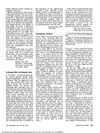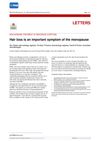TLDR "Male-pattern" hair loss is common in women, especially after menopause, and doesn't always mean there's a problem with hormone balance.
In 1988, a study involving 564 women discovered that patterned hair loss, typically associated with men, was more prevalent in women than previously believed, especially after menopause. The research showed that 13% of premenopausal women and 37% of postmenopausal women experienced frontal and frontoparietal hairline recession. The study concluded that "male-pattern" hair loss in women does not necessarily indicate abnormal androgen metabolism, as it is common in the general population, particularly among postmenopausal women. The researchers stressed the need to consider a woman's menopausal status when assessing the significance of patterned hair loss.
46 citations
,
June 1983 in “Cleveland Clinic Journal of Medicine” Higher DHEAS levels may cause hair loss in women by disrupting hair growth.
 666 citations
,
September 1977 in “British Journal of Dermatology”
666 citations
,
September 1977 in “British Journal of Dermatology” Common baldness, also known as Androgenetic Alopecia, is caused by a combination of genetic factors and hormones called androgens.
 7 citations
,
June 2019 in “Australasian Journal of Dermatology”
7 citations
,
June 2019 in “Australasian Journal of Dermatology” AGA in children needs careful diagnosis due to low androgen levels and possible other causes.
 1 citations
,
January 2018 in “BMJ”
1 citations
,
January 2018 in “BMJ” Many women experience significant hair loss during menopause, and topical minoxidil is an effective treatment.
December 2002 in “대한피부과학회지” Higher androgen receptor levels in bald areas may cause hair loss, while estrogen receptors have less impact.
 1 citations
,
December 1992 in “International Journal of Dermatology”
1 citations
,
December 1992 in “International Journal of Dermatology” No significant hormone differences found in postmenopausal women with androgenetic alopecia.
 124 citations
,
August 1990 in “British Journal of Dermatology”
124 citations
,
August 1990 in “British Journal of Dermatology” Diffuse alopecia in women may be related to androgens and iron deficiency, and basic hormone and nutrient screening is useful.
 130 citations
,
May 1988 in “Journal of The American Academy of Dermatology”
130 citations
,
May 1988 in “Journal of The American Academy of Dermatology” "Male-pattern" hair loss is common in women, especially after menopause, and doesn't always mean there's a problem with hormone balance.







